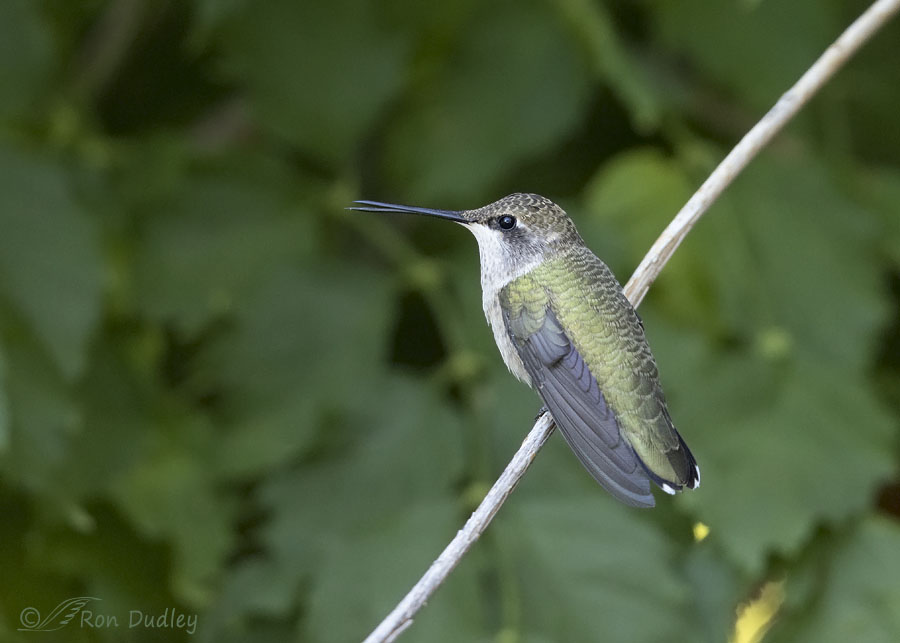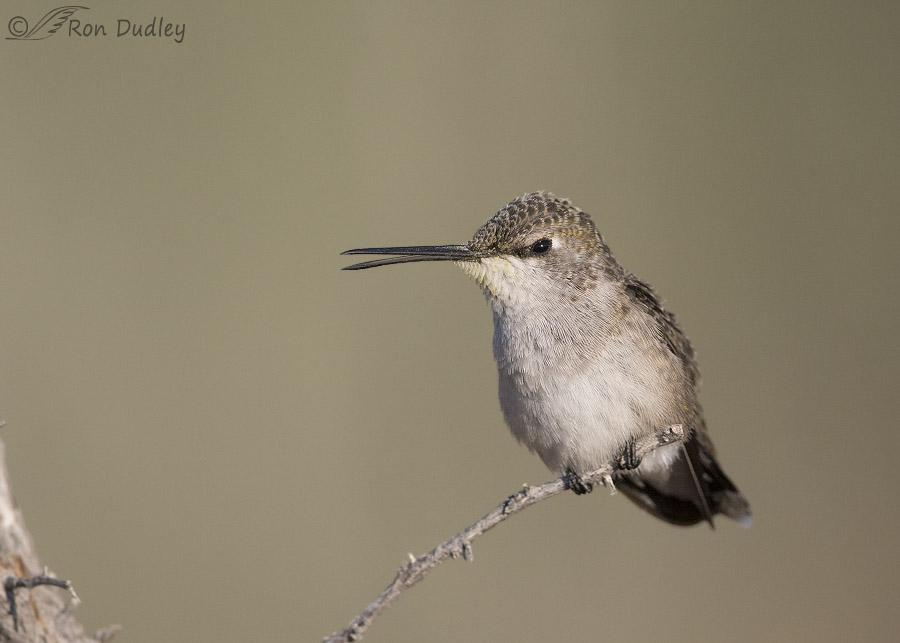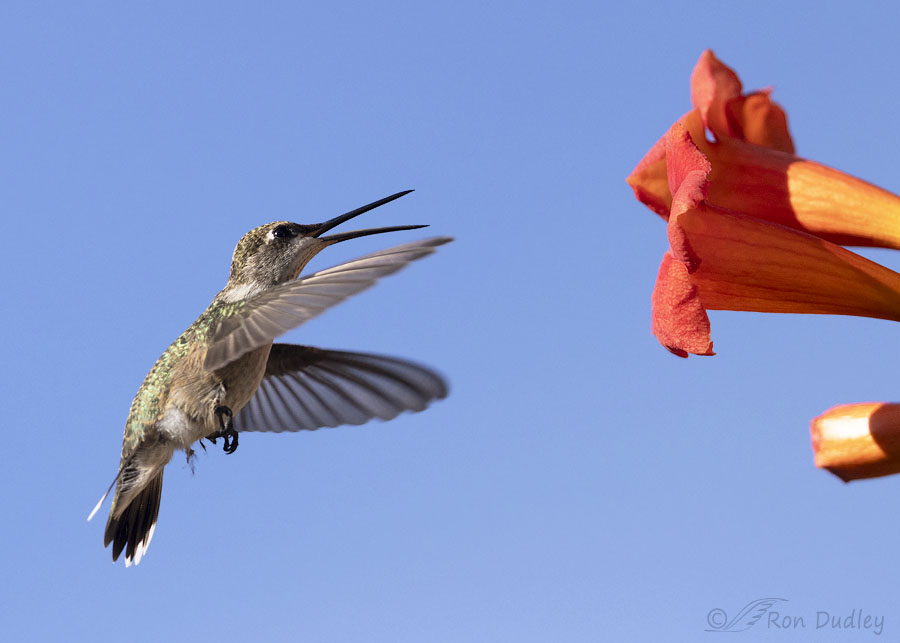I was.
Lots of folks think hummingbirds can’t open their bills at all. They assume their bills are straight (usually), rigid, hollow tubes used only for drawing up nectar from flowers and hummingbird feeders – kind of like a straw.
But hummers need protein too, so tiny insects are part of their diet and capturing them requires opening at least the distal end of their bill.

I suspect that most followers of Feathered Photography are fully aware that hummers can open the ends of their bills at least this much, using rhynchokinesis to flex the end of their bill.

Until recently this is about as wide as I’ve ever captured a hummingbird bill open in my photos. I’ve always suspected that they could open their bill all the way to its base but I’d never documented it that I can recall.

1/5000, f/5.6, ISO 1000, Canon R5, Canon EF500mm f/4L IS II USM + 1.4 tc, not baited, set up or called in
But two days ago I caught this immature (I think) Black-chinned Hummingbird with its bill wide open. This isn’t rhynchokinesis, or bill-bending, It’s the opening of the entire bill all the way to where it meets the skull and it’s open pretty wide, at least for a hummingbird.
And who knows, maybe they can open their bills even more than this. I’ll be watching for it.
Ron
Note: All this has me thinking. I’ve photographed many species of birds yawning but I’ve never captured a hummingbird yawning. I wonder if they do…


Never having seen a hummingbird it wasn’t a question that had ever occurred to me.
Thank you (so much) for continuing my education.
You’re very welcome, EC. As you can see, I’m learning too.
#3 – What a wonderful study in V’s! The negative-space, blue-sky angles made by the open beak and the wings on the left are reflected in the solids of the trumpet vine flowers on the right. (Did that hummer use little calipers to get his beak angle and wing angle the same?!)
Once again, you combine the art and the science! Lovely!
Thanks, Carolyn. Nope, I never saw any calipers…
We have a 2nd wave of Rufous coming through Have witnessed them successfully catching and eating insects in flight with open mouth. Hummers are SO delightful and fascinating. Love them and love your open mouth capture photo! Very precious.
Have witnessed them successfully catching and eating insects in flight with open mouth. Hummers are SO delightful and fascinating. Love them and love your open mouth capture photo! Very precious.
I’m still waiting for a first wave, Kathleen. Still haven’t seen a single Rufous. Very unusual.
Unfortunately, the population of Rufous Hummingbirds is in serious decline. The State of the Birds Report for 2022 reports that two thirds of the population had disappeared since 1970. Habitat loss in breeding range and in winter range is part of the blame. Other problems include climate change, cats and window collisions We have seen Rufous at our feeders only a couple of times this year but far fewer than previous years.
Damn, I hate to hear that, Dan. Rufous may be my favorite hummer, probably because of their feistiness.
Great shot of something seldom seen. Distal rhynokinesis (flexing just the tip of the upper portion of the bill) is well known in shorebirds with long bills. There are many other forms of rhynokineses that don’t involve just the tip flesing. I’ve only seen one reference to this in hummingbirds and it was just a checkmark in a chart with no details in the article. Your photo clearly shows the mandible being moved downward with no flexion of the upper portion of the bill (maxilla).
You mentioned sucking up nectar. Just for clarity, I’m sure you are aware that hummingbirds do not suck up nectar, but it’s a common misconception. Nor is it by capillary action. Tiny flaps on either side of the tongue open flat as the tongue enters the nectar. As the tongue is withdrawn, these flaps sequentially roll up trapping nectar unti the tongue is withdrawn into the mouth.
Thanks for the info, Dan. I actually said “drawing”, not “sucking”… I did mention a straw but that was when I was talking about what people assume.
I did mention a straw but that was when I was talking about what people assume.
My apologies. I know you didn’t said drawing but when I was responding my brain flipped to sucking which so many peopkle assume. I know you know what’s real but it’s such a widespread misconception I just wanted to elaborate.
It looks like my comment about Rufous Hummingbird decline may not have gone through. (Reply to comment below Kathleen) I think I see why. It looks like somehow a 2 got added to my email. Any way of fixing that? I can resend it that’a better.
No problem, Dan. None at all. I just wanted you to know that I knew.
I found your second comment in my WordPress app and approved it.
They can open the beak very wide if they want to. This shot was in low light and I did not see the insect until processing.
/Users/charlesbaughman/Desktop/HUMMER AND INSECT (1 of 1).jpg
Charles, I opened your link but all it took me to was a page of Bing search results.
Yes, they yawn, yes their beak opens surprisingly far. I don’t know if I have photos but I have witnessed it while feeding nestlings and watching them in a rehab setting, also along with watching birds hawking insects out of the air.
Good to know, April. Thanks.
I get to learn something new before breakfast! Coolamatious! Thanks, Teech!
You’re very welcome, Marty.
They’ll open their bills this wide when they are hunting and grabbing gnats and flying insects out of the air. Besides dining on nectar, hummingbirds also eat flying insects for the protein, especially when they are raising young.
“also eat flying insects for the protein”
As I mentioned in my post…
Never knew of rhynchokinises. Tried to read about it but the pubmed articles were tough for my early morning brain. The bug remains on our walls by their nest attest to the insect eating of the nestlings though
Catherine, I saw some of those articles. Many of them would be hard to wade through.
Very interesting Ron – I have photos of hummers looking like your first photo, but none with that further extension. Don’t think I was ever aware that they could do that. Thanks again for another biology/science lesson from the old teacher.
“Old” teacher – you’ve got that right! Thanks, Everett.
Ohmygosh ! “Rhynchokinesis” is an ability I never would have
dreamed that a bird’s beak could possess–maybe there are tiny
little tendons in it ? Thanks once again for presenting the wonders
of nature–I love “tuning in” every morning with the possibility of
learning something like this…….
“I love “tuning in” every morning with the possibility of
learning something like this”
That made my day. Thanks, Kris.
WOW! I’ve never seen nor even thought about how far they can open their beaks tho I did know they eat bugs……. Good capture, Ron!
Thanks, Judy.
Another lesson from the FP professor.
Have see the partially open beak of the hummers, but had no idea about rhynchokinesis. And I have never seen a hummer with it’s beak open that wide before (photo #3).
Much gratitude for the new knowledge.
Thank you, Michael.